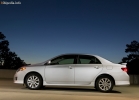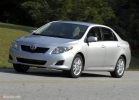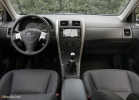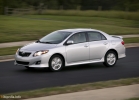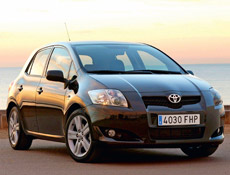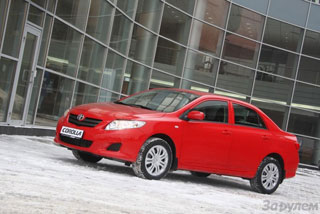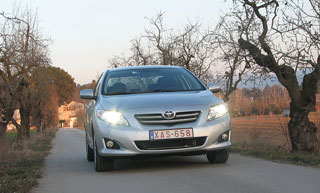Test Drive Toyota Corolla 2007 - 2009 Hatchback
Test a new Toyota Corolla
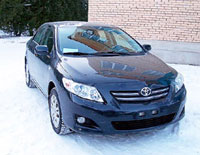 Sales of the Toyota Corolla 2007 model year will begin in the next few weeks, but official dealers are already concluded with customers with preliminary contracts with the delivery time of April of the current year. Cars arriving in Russia in February and March are already sold out. And this is despite the fact that today cars are not yet presented in Dealers' demonstration halls, and buyers make a decision only on the basis of a few official photos. However, several cars are already in Moscow. Some of the first, who managed not only to see a new Corolla, but also to test her on the road, were the Toyota Club Russia experts who kindly agreed to tell us about their impressions.
Sales of the Toyota Corolla 2007 model year will begin in the next few weeks, but official dealers are already concluded with customers with preliminary contracts with the delivery time of April of the current year. Cars arriving in Russia in February and March are already sold out. And this is despite the fact that today cars are not yet presented in Dealers' demonstration halls, and buyers make a decision only on the basis of a few official photos. However, several cars are already in Moscow. Some of the first, who managed not only to see a new Corolla, but also to test her on the road, were the Toyota Club Russia experts who kindly agreed to tell us about their impressions. Meetings with the new Corolla we have been waiting for a long time ago. Increased interest in the new model was due not only to banal curiosity, but also a colossal amount of rumors that have recently appeared around the car. Most questions caused a robotic mechanic, also known as a multi-modal transmission (MMT). It is such a box of Toyota Motor Corporation that decided to replace the 4-step automatic on the previous generation of Corolla.
In the past few years, robotic PPCs are universally installed by various manufacturers on new cars, however, reviews about the operational characteristics of these boxes are very contradictory. In essence, the multi-modal transmission is nothing but the usual mechanical gearbox, switching gear and clutch disclosure on which is not carried out by the driver, but three electric motors. Compared to conventional mechanics, such a design is more convenient for the driver, but, nevertheless, loses the traditional automatic transmission at the gear shift speed. It was the delay when switching until recently was one of the most important minuses of multi-modal transmission, in particular, strongly poisoning the life of the recent generation of Honda Civic.
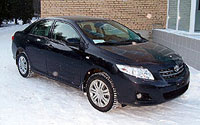 Due to the fact that the new Toyota Corolla will be supplied to the Russian market only with a mechanical and robotic transmission, going to the test drive of the new car. We set up two main tasks. First, it was extremely interesting to compare a new model with the previous generation Corolla, and secondly, we had to appreciate the work of robotic checkpoint with special addiction.
Due to the fact that the new Toyota Corolla will be supplied to the Russian market only with a mechanical and robotic transmission, going to the test drive of the new car. We set up two main tasks. First, it was extremely interesting to compare a new model with the previous generation Corolla, and secondly, we had to appreciate the work of robotic checkpoint with special addiction. Little Camry.
Actually, the car is from MMT and appeared in front of us on the Moscow Region Auto Polygon. We got a car in not the poorest configuration with an index 32, which will be offered by official dealers for $ 22,700. Equipment of the machine to some extent resembles the configuration of the previous generation, however, has a number of serious differences.
Even in the fiscal version itself, the car is equipped with front and rear disk brakes with ABS and EBD systems, four airbags, immobilizer, a central locking castle, air conditioning and heated and electric side mirrors, electrical windows, and a CD receiver with four speakers. On the simplest equipment, the steering wheel is made of polyurethane, and on vehicles with robotic mechanics, the ram is equipped with also petals of MMT transmission control. The price of machines with such equipment ranges from $ 18,600 per car with a motor 1.4 (97 hp) and mechanical gearbox, up to $ 21,000 per machine with engine 1.6 (124 hp) and multi-modal transmission. In the configuration that we got for a test drive, the rear power windows were added to all the listed. System and front fog lights.
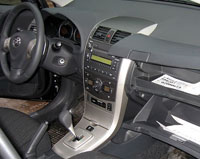
Motor with a motor 1.4 liters are supplied to the Russian market with wheels and tires 195/65 / R15, the machine with a motor 1.6 l is equipped with 205/55 / \u200b\u200bR16. Alloy wheels are available only on Corolla in the maximum configuration with an index 60, the price of which is already $ 24,600. In addition to wheel drives, this equipment is different from the presence of the light sensor, the rain sensor, the electrical rear view mirror, cruise control, the access system in Salon and Start SMART Entry & Push Start Engine.
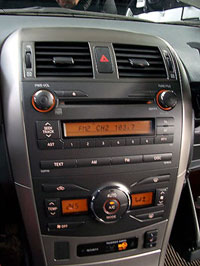 Unlike the previous generation of Corolla, a new car has gained two pleasant additions to the settings that were not enough in the 2003 model year cars. The CD receiver, to the joy of fans of the brand, now knows how to play not only the usual Audio-CD, but also to reproduce the people's format MP3. And on the front bumper, even on the machines in the minimum version, headlight washers are present.
Unlike the previous generation of Corolla, a new car has gained two pleasant additions to the settings that were not enough in the 2003 model year cars. The CD receiver, to the joy of fans of the brand, now knows how to play not only the usual Audio-CD, but also to reproduce the people's format MP3. And on the front bumper, even on the machines in the minimum version, headlight washers are present. The appearance of Toyota Corolla 2007 has already caused a lot of disputes. The design of the car can like, maybe not like, but he will not leave anyone indifferent. If the appearance of the previous generation can be called frankly inexpressive, then you can't tell this new Corolla. Little Camry The first thought that came to our mind when we saw this car alive. The shape of the radiator grille, the predatory headlights, two longitudinal faces of the hood, smoothly flowing into the side of the side glasses, rising in the back of the body, the new oval rear optics and the aggressive rear bumper give the exterior of the car a somewhat sporty character, advantageously emphasizing individuality. Those who have risen the appearance of the previous Corolla have disappeared and savaged from the Moscow dirt who have worn under them, plastic linings on the bottom of the thresholds. In general, we had the feeling that the Toyota designers finally had achieved something that was so lacked by the owners of the previous generation Corolla - the car gained individuality.
What's new in the cabin
No less attractive was the salon. By changing the windshield tilt angle, the front panel became deeper, and moved somewhat compared to the previous Corolla. The upper part is finished with soft gray plastic, and the central console has gained a silver shade. The quality of materials and fitting panels are traditionally for Toyota, and we did not cause complaints. It is noteworthy that instead of a cold green shade, the lighting of the radio, the climate and instrument control unit now emits a soft cozy amber light.
 The combination of devices is, no doubt, one of the most remarkable improvements to the new Corolla. Unlike the previous model, the screening of the onboard computer is now displayed on a special round display, located in the center of the speedometer, which also displays the testimony of the odometer, two per diets, and even signaling the opening of the trunk lid. The second same round display is located in the center of the tachometer, and displays the fuel level in the tank and the temperature of the coolant, as well as the mode of operation of the multi-modal transmission. Between the speedometer and the tachometer were attached control lamps for the driver for the driver, which on cars with mechanical gearbox signals the need to enable increased or reduced transmission.
The combination of devices is, no doubt, one of the most remarkable improvements to the new Corolla. Unlike the previous model, the screening of the onboard computer is now displayed on a special round display, located in the center of the speedometer, which also displays the testimony of the odometer, two per diets, and even signaling the opening of the trunk lid. The second same round display is located in the center of the tachometer, and displays the fuel level in the tank and the temperature of the coolant, as well as the mode of operation of the multi-modal transmission. Between the speedometer and the tachometer were attached control lamps for the driver for the driver, which on cars with mechanical gearbox signals the need to enable increased or reduced transmission. Plastic doors is almost identical to the materials of the previous generation Corolla, but the coverage of the seats has become softer and pleasant to the touch. In contrast to the previous generation, the cup holders in the tunnel between the seats are now covered with folding lids. The seats themselves, although they do not have developed lateral support, tenaciously hold in turns of the driver of the average set, and the modified shape of the head restraints now allows them to use them in direct appointment without risking at the same time to get the neck muscles stretching. Driving seat is adjustable horizontally and vertical, and for the driver height 180 cm horizontal adjustment is quite enough. The rear seats were also pretty comfortable, the space for the feet of the rear passengers remained almost unchanged, adding, according to the manufacturer's assurance, 1 cm long.
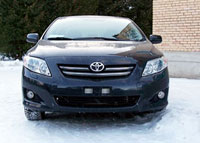 The front speakers of the radio all are also in their places in the lower front of the doors. But the rear moved from the doors on the shelf, freeing the place for glove boxes with built-in cup holders. The rear shelf itself will now not serve as a refuge for abundant clusters of dust, however, risks the source of additional squeaks, the shelf cover is not made of cardboard and tissue, but from solid plastic.
The front speakers of the radio all are also in their places in the lower front of the doors. But the rear moved from the doors on the shelf, freeing the place for glove boxes with built-in cup holders. The rear shelf itself will now not serve as a refuge for abundant clusters of dust, however, risks the source of additional squeaks, the shelf cover is not made of cardboard and tissue, but from solid plastic. In general, the Salon of the New Corolla, in addition to significant visual improvements, found three improvements, which, no doubt, will appreciate the owners of the 2003 model years cars. First, on the new model, Toyota finally abandoned the inconvenient adjustment mechanism for adjusting the backrest of the front seats. Now the lever is right enough to raise up, and the back can be lowered and lifted as much as you like. To fix it is enough to return the lever to its original position. Secondly, due to the fact that the main muffler was moved closer to the engine compartment, the high tunnel disappeared, separated by the floor in the legs of the rear passengers. And, thirdly, the rear seat got a folding armrest with two built-in shallow sleepers.
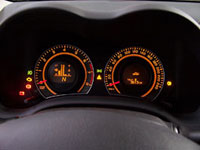 We were not too lazy to look into the trunk. There we were waiting for another surprise. From now on, a hinge for fastening a mesh, holding a luggage appeared to the universal joy of owners in the trunk of Toyota Corolla. Everything else, including the upholstery material and a full-size spare, remains unchanged.
We were not too lazy to look into the trunk. There we were waiting for another surprise. From now on, a hinge for fastening a mesh, holding a luggage appeared to the universal joy of owners in the trunk of Toyota Corolla. Everything else, including the upholstery material and a full-size spare, remains unchanged. Pros and Cons Boxes
After reviewing the inner world of the new Corolla, we started directly to the road test, which was spent on the Moscow Region Auto Polygon. As we have talked above, at our disposal was Corolla with a 1.6 liter engine. Power 124 hp and the very multi-modal transmission. Of particular interest to the event attached to the fact that a few days before the test drive in Moscow there was rich snowfall, and the test tracks of the landfill were covered with ice and snow, as close as possible the test drive conditions to the average Russian winter realities.
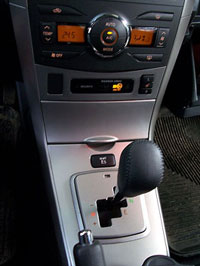 It was comfortable to accommodate the driver's workplace within a minute. The first thing that rushed a significantly improved review. By changing the angle of inclination of windshield and reduce the thickness of the side front racks, the dead zones created by these shelves decreased almost 2 times. We did not measure the diameter of the steering wheel, but it seems that it has decreased compared with the previous generation.
It was comfortable to accommodate the driver's workplace within a minute. The first thing that rushed a significantly improved review. By changing the angle of inclination of windshield and reduce the thickness of the side front racks, the dead zones created by these shelves decreased almost 2 times. We did not measure the diameter of the steering wheel, but it seems that it has decreased compared with the previous generation. Multi-modal transmission in fact actually has 3 modes of operation M, E and ES. In M mode (Manual), the selection of the transmission is carried out by the driver, by pressing the PPC selector: the choice of increased transmission is carried out by pressing down, the choice is low. The mode E corresponds to the usual Drive in the traditional automaton when the gear selection is carried out without the driver's participation, but the engine turns do not rise above 3500. In ES mode, which is included with the button located on the center console before the gearbox lever, the gear selection is also carried out by electronics, However, switching occurs already in the area of \u200b\u200b6000 revolutions per minute. In all three modes, the driver has the ability to forcibly switch transmission using petals located behind the steering wheel.
After examining the driver's workplace and the principles of controlling robotic gearbox, fasten and start the engine. Immediately feel that it works significantly quieter than on the Corolla of the previous generation. Looking ahead, let's say that after the engine warming, we failed to experience light vibrations at idle, so characteristic of the old motor 1.6, and caused by the low quality of Russian gasoline.
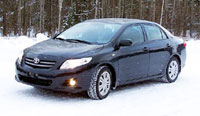 We translate the gearbox to the E position, let go of the brake, press gas and go. A delay and a light jerk that accompanied the moment of starting movement at Toyota Yaris and Corolla Verso, equipped with multi-modal transmissions, are not bad. We press gas about 2/3 and type the speed. It is necessary to recognize 124 horsepower of the new engine 1.6 accelerate the car somewhat active than 110 horsepower of the old engine. But we, with bitter experiences of the functioning of the robot on Verso, do not hurt to draw conclusions, and, without removing the leg with the pedal of gas, we wait for the dynamics and pauses when switching the gears from the first to the second. The moment comes the engine turns fall, the car loses the dynamics at the fraction of a second, he jerks a little and again starts overclocking. Other things! Here you need to clarify that the new Toyota Corolla is installed the same multi-modal transmission as the Corolla Verso, however, with changed software and several constructive improvements. As our test showed this turned out to be quite enough. Of course, such a transmission has not yet reached in the speed of switching gear to the traditional automaton. But this is not a mechanic, and of course, not the robot that pulls the car during acceleration, and most importantly provides dynamics failures and wanted spending between shifts.
We translate the gearbox to the E position, let go of the brake, press gas and go. A delay and a light jerk that accompanied the moment of starting movement at Toyota Yaris and Corolla Verso, equipped with multi-modal transmissions, are not bad. We press gas about 2/3 and type the speed. It is necessary to recognize 124 horsepower of the new engine 1.6 accelerate the car somewhat active than 110 horsepower of the old engine. But we, with bitter experiences of the functioning of the robot on Verso, do not hurt to draw conclusions, and, without removing the leg with the pedal of gas, we wait for the dynamics and pauses when switching the gears from the first to the second. The moment comes the engine turns fall, the car loses the dynamics at the fraction of a second, he jerks a little and again starts overclocking. Other things! Here you need to clarify that the new Toyota Corolla is installed the same multi-modal transmission as the Corolla Verso, however, with changed software and several constructive improvements. As our test showed this turned out to be quite enough. Of course, such a transmission has not yet reached in the speed of switching gear to the traditional automaton. But this is not a mechanic, and of course, not the robot that pulls the car during acceleration, and most importantly provides dynamics failures and wanted spending between shifts. 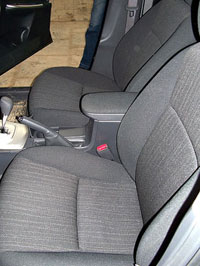 Watching the transmission process without letting the gas pedal, we decided to try the method directly recommended for machines with MMT. We spin up the engine to 3000 revolutions per minute, release a little gas and instantly return it to its original position. This is true. A moment for which we let go of the gas pedal, the robot turns out to be enough to switch the transmission up. At the same time, due to the fact that we ourselves reduced the revolutions, dropping the gas, barely noticeable jerks, which is present when the gas pedal is pressed, is practically absent. The same happens when switching down. We reset the gas without letting the pedal until the end, then we first accept it, again press the robot has already turned on reduced gear. Not bad.
Watching the transmission process without letting the gas pedal, we decided to try the method directly recommended for machines with MMT. We spin up the engine to 3000 revolutions per minute, release a little gas and instantly return it to its original position. This is true. A moment for which we let go of the gas pedal, the robot turns out to be enough to switch the transmission up. At the same time, due to the fact that we ourselves reduced the revolutions, dropping the gas, barely noticeable jerks, which is present when the gas pedal is pressed, is practically absent. The same happens when switching down. We reset the gas without letting the pedal until the end, then we first accept it, again press the robot has already turned on reduced gear. Not bad. Pleased and kickdown. A fairly fast response to pressing gas and good overclocking (thanks to the new engine equipped with the DUAL VVT-I system). But for us this is not enough and we press the ES button, translating MMT into the sports mode. Motor cheerfully spins up to 6000 revolutions per minute, the behavior of the robot is identical to the regime E. Not releasing gas pedal When switching, we obtain a small delay required by the robot in order to reset the gas and squeeze the grip. Resetting the same gas at the moment when we want to switch the speed to get smooth, quite acceptable switching. In M mode, everything happens about the same way, with the only difference that the speed chooses not a robot, but the driver by the gearbox selector. Under the gas discharge, smooth switching, without letting the pedal, a slight delay and a slightly noticeable push, which, again, depends on the magnitude of the engine speed.
By the way, the manufacturer declares the possibility of manual gear shift in any of the three MMT modes with the help of petals under the wheel. Indeed, everything works, and the petals are very convenient. They pulled on themselves the right petal switched the gear up, pulled the left down.
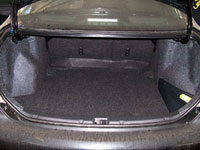 But, despite the general favorable impression, the robotic gearbox new Corolla still has two serious drawbacks. They can be fully felt only on the rise. The first drawback is characteristic of all robotic boxes. We are moving at a raising at a speed of about 40 km / h, stop to check how the robot can touch the slide on the ice. Transfer the selector to E mode, let go brake and the car starts to roll back. Again the brake, pressing the gas at the same time with the release of the brake slightly slots, the car boils on the rise. Nothing can do all the robots when the gas pedal is released in the direction of inclination. Well, the owner will be forced to use the handbrake more often, and manipulate the brake pedal when starting to the slide. It seems to be nothing. However, when the engine is turned off, in any position of the gearbox selector, the machine can also turn. Here it is necessary to use only a manual brake, and what is fraught with a night parking machine on the handbraft in the frost knows, probably every driver.
But, despite the general favorable impression, the robotic gearbox new Corolla still has two serious drawbacks. They can be fully felt only on the rise. The first drawback is characteristic of all robotic boxes. We are moving at a raising at a speed of about 40 km / h, stop to check how the robot can touch the slide on the ice. Transfer the selector to E mode, let go brake and the car starts to roll back. Again the brake, pressing the gas at the same time with the release of the brake slightly slots, the car boils on the rise. Nothing can do all the robots when the gas pedal is released in the direction of inclination. Well, the owner will be forced to use the handbrake more often, and manipulate the brake pedal when starting to the slide. It seems to be nothing. However, when the engine is turned off, in any position of the gearbox selector, the machine can also turn. Here it is necessary to use only a manual brake, and what is fraught with a night parking machine on the handbraft in the frost knows, probably every driver. The second drawback will not seem so obvious, but it is a little embarrassed. As we have already written above, the driver has the ability to switch the transmissions of the submissive switch petals both in mode E and in ES mode. After a while, after the driver adaptively switches the transmission, or after the short release of the gas pedal, the checkpoint is again returned to the automatic mode. And to return to the ES mode, you need to press the button again, and it's not entirely convenient to reach it.
 One example. At the beginning of the next circle, we include the ES mode, we pass the track without interfering with the behavior of the robot, and at the entrance to the icing rise, we force the second gear, press gas, and we pass with a small demolition of the front axle. Then the rise begins. We gradually reset the gas, the robot switches to the 4th gear, and the car begins to lazily climb the slide. Squeeze the gas, not cycling the kikdown, but the speaker does not improve. Turns around 3000, remember the submissive petals, trying to turn on the 3rd speed. But the robot does not want to motivate his stubbornness by the fact that it is in E mode, and in this mode of engine speed is not able to maintain above 3000. It is useless to argue with a robot, we translate the gearbox in the M mode M, and already include the 3rd transmission. In general, it is possible, but if the robot initially returned to ES mode, it would be much more convenient.
One example. At the beginning of the next circle, we include the ES mode, we pass the track without interfering with the behavior of the robot, and at the entrance to the icing rise, we force the second gear, press gas, and we pass with a small demolition of the front axle. Then the rise begins. We gradually reset the gas, the robot switches to the 4th gear, and the car begins to lazily climb the slide. Squeeze the gas, not cycling the kikdown, but the speaker does not improve. Turns around 3000, remember the submissive petals, trying to turn on the 3rd speed. But the robot does not want to motivate his stubbornness by the fact that it is in E mode, and in this mode of engine speed is not able to maintain above 3000. It is useless to argue with a robot, we translate the gearbox in the M mode M, and already include the 3rd transmission. In general, it is possible, but if the robot initially returned to ES mode, it would be much more convenient. What will affect hijackers?
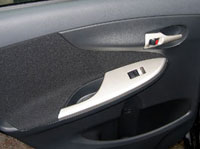 Otherwise, there seems to be no complaints about the car. We had the impression that, compared with the previous generation, Corolla, the center of gravity shifted a bit down, and due to this, the car not only began to be managed much more interesting, but also acquired greater sustainability on the road. When turning turns, the demolition of the front axle begins slightly later than on the previous generation. As for the unpredictable drift of the rear axle, so characteristic of the old Corolla, then the new car has failed to identify this harmful habit. Perhaps a large role in improving the behavior of the car was played by a new design of the rear beam with spaced springs and shock absorbers. In general, the controllability of Corolla 2007, in comparison with the 2003 model year, seriously improved.
Otherwise, there seems to be no complaints about the car. We had the impression that, compared with the previous generation, Corolla, the center of gravity shifted a bit down, and due to this, the car not only began to be managed much more interesting, but also acquired greater sustainability on the road. When turning turns, the demolition of the front axle begins slightly later than on the previous generation. As for the unpredictable drift of the rear axle, so characteristic of the old Corolla, then the new car has failed to identify this harmful habit. Perhaps a large role in improving the behavior of the car was played by a new design of the rear beam with spaced springs and shock absorbers. In general, the controllability of Corolla 2007, in comparison with the 2003 model year, seriously improved. We had the impression that the car was successful. There were a lot of doubts about the quality of the interior trim materials, the work of the multi-modal transmission, however, the test drive helped us to answer two questions that we were asked ourselves.
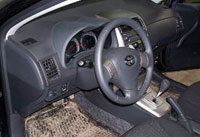 First, Corolla 2007 did not at all recently restyling the previous body. Despite the fact that changes in the design are not global, the new Corolla is a really new car, which is very serious from the previous one and in comfort, and on dynamics and by manageability.
First, Corolla 2007 did not at all recently restyling the previous body. Despite the fact that changes in the design are not global, the new Corolla is a really new car, which is very serious from the previous one and in comfort, and on dynamics and by manageability. Secondly, we personally were convinced that the final multi-modal transmission is no longer the reason for refusing the acquisition of the machine. We are not inclined to idealize Toyotovsky multi-mod, but, compared with MMT Yaris and Corolla Versa, this is really a huge step forward.
It seems the only serious problem that is waiting for the owners of the new generation of Corolla, it is a potential huge popularity of hijackers. Seeing the car live. We understood that it would be treated much more often than Corolla 2003.
A source: AUTO.Mail.Ru.
Video crash tests Toyota Corolla 2007 - 2009
Toyota Corolla 2007 Test Drives - 2009
Toyota Corolla 2007 Crash 2007 - 2009
Crash Test: Details34%
Driver and passengers
23%
Pedestrians
39%
Children-passengers


